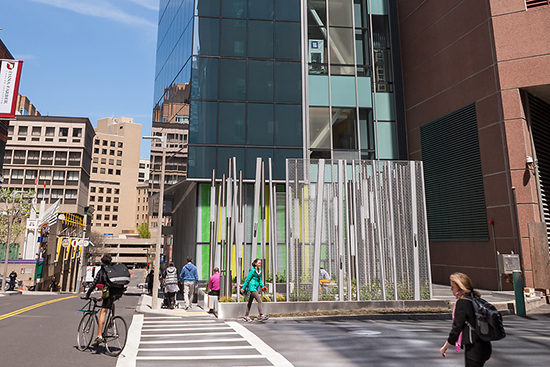Last winter I found myself touring nursing homes with my two sisters. One of those types of places you hope to avoid but if you must, then hopefully a pleasant environment for your loved one. As expected the quality of the ambiance and finishes seemed to be reflected in the monthly fees. As a designer I think my reaction to the various places we visited was quite different than my non-designer sisters. After you determine that yes your loved one would be reasonably happy here, your thoughts go to; Would I be reasonably happy here 25 to 30 years hence? Would I appreciate the fake flowers on the tables and brass sconces in the hallways? And, what is it with that wallpaper in the dining room! But what surprised me was not the libraries full of what I imagined were endless supplies of Agatha Christie novels, it was the video area. An older gentleman was playing Wii golf. I should not have been surprised because I have read about the advantages of video game activities for the elderly; it gets you up on your feet and is a social activity for many participants.

For my future elderly self, I have never been much of a golfer, so no Wii golf for me, so how about Need for Speed or the Gran Turismo racing game – zooming through the streets of Paris or London, rushing around the Nuremberg Ring – all at the flick of a switch on my Xbox One! In these games I’m driving cars I could never afford in the working world. In 25 or 30 years we should have access to something more powerful than an Xbox. Not some hand held controller and a 35 inch 3-D TV, no, it will be more like a ‘Cave’ or the holodeck from Star Trek. This could be a fully immerse 3D environment. This leads me to wonder; would this be limited to the ‘game room’ or could the whole nursing home be some sort of virtual environment?
What if we have “French Week” at the facility? The kitchen would prepare French food and the holodeck visually transports us all to Paris for Fashion Week or the South of France to drink wine, if my taste buds are still working, and Le Mans if I can stay up for 24 hours! Could one expect to live in a virtual world of your choosing?
Does this all seem a bit over the top? We are living in an ever increasingly virtual world. In the not so distant future could apartments be fitted out as black boxes or white rooms where you get to choose your décor at the press of a button. Walls and ceiling made of 3-D screens on which you can call up a vast array of different images; the Sistine Chapel one minute then a grass hut on a Pacific Island beach the next. The where of your choice and more interestingly the when! History buffs could have a field day, literally. The menu could be limitless.
If you can imagine a world in which we start to live in increasingly virtual environments, will our so called real environment matter as much? If your 600 SF apartment, in some 40 story high rise in the city of the future, was a virtual hut on a beach in Maui would you be happier with painted drywall and a couple of framed prints on the wall? The color of your apartment could be different every day if you have the wallpaper app with over 10,000 choices! Would you give up tangible decoration for an ever changing virtual one? Especially if it was interactive! Smell the ocean, feel the breeze. Well, would you?
What of architects and designers in this future virtual world? Maybe all those architectural grad students who turned their backs on architecture and went off to design virtual worlds for the gaming industry and Hollywood were ahead of the curve. Five or ten years from now some great designer of virtual worlds will come out of this industry and start developing housing for a generation that has already spent 10,000 hours immersed in Bioshock or all the various versions of Call of Duty, you could even live next door to the Simpsons, or better yet in the Bat Cave!
Is this vision a nightmare or the ultimate gaming/living/entertainment environment just right for the end of a long day at work? Is this idea a wonderful escape for the elderly who would prefer not to deal with the present? Could this vision become the equivalent of a glass of wine for the working stiff? What about pop-ups? Right in the middle of your Tuscan interlude appears an advert for Cheese Whiz or tooth paste! How will we pay for all this virtual fun? There is always a catch.
No matter if a future virtual world does not quite match my description above one does wonder where the focus of design will center in the not-too-distant future. As our reliance and interaction with interactive virtual technology increases how will we spend a good portion of our time? How will we shop, work, interact, relax? Do you buy most of the stuff you think you need online, without an interaction with a sales person, waiting for a drone to deliver it? Can you work at home all day without talking to someone back at the office? How many couples have you seen in a restaurant both on their smart phones ignoring each other? How many of our kids play interactive video games sitting by themselves for seemingly endless hours in the TV room or talking to other unseen kids on the other side of the world. Or just endlessly texting; have people forgotten that it is also a phone, you know, a device for talking to each other? Then again, who needs to actually speak to anyone real anymore if we have Siri?
Will living in cities of increasing density drive us to escapist virtual environments to help us cope? Will we work at home sitting in our virtual grass hut on the beach with our laptop and cup of coffee, rarely venturing out into the real world? Or can we design our cities to be places where we will still want to interact with each other, go to the theatre, the museum, coffee shops in the park, shop on Main Street, be a fan at Fenway Park … all the things that make us a community and a culture.
Maybe the challenge in the future will not only be how to design for interactive technology: streets that talk to autonomous cars, buses and taxis; housing that tells you when to go to work, turn the heat down, and what you need to buy for the refrigerator; handheld devices that organize our daily lives. Maybe the challenge will be how to help us all unplug from time-to-time and interact face to face; and I don’t mean Facebook. It’s essential to create space that we want to occupy with our families and friends that doesn’t rely on some sort of nanny technology and provides real deal; human interaction. Designing places about people, not about and for our technology. Shakespeare once said “What is the city but the people,” (The Tragedy of Coriolanus, Act 3, Scene 1) not just so much bricks and mortar in the 16th Century, not just so much connected interactive technology in the 21st Century. An observation made nearly 400 hundred years ago that hopefully will continue to ring true in our future.
Related:
Fashion Insiders Weigh In: Can Your Style Survive Google Glass?


